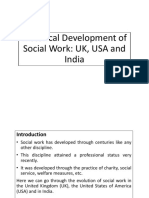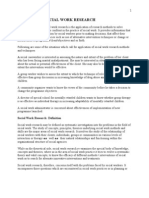100%(4)100% found this document useful (4 votes)
4K viewsDevelopment of Social Case Work in U.k, Usa and in India
Development of Social Case Work in U.k, Usa and in India
Uploaded by
ADARSH SINHAThe document summarizes the development of social case work in the UK, USA, and India from the 19th century to present day. It traces the origins of organized charity work in London in 1869 and how this model spread to establish "friendly visitors" and later paid agents in the UK and US. Formal social work education began in the late 19th century, and case work methodology was established by 1911 in the US. Case work was influenced by Freudian theory and adapted in response to world events like World Wars and economic crises. India's social case work was influenced by American models and the first professional social work school was established in 1936. The document notes some limitations of directly applying Western social case work models to India.
Copyright:
© All Rights Reserved
Available Formats
Download as PPTX, PDF, TXT or read online from Scribd
Development of Social Case Work in U.k, Usa and in India
Development of Social Case Work in U.k, Usa and in India
Uploaded by
ADARSH SINHA100%(4)100% found this document useful (4 votes)
4K views6 pagesThe document summarizes the development of social case work in the UK, USA, and India from the 19th century to present day. It traces the origins of organized charity work in London in 1869 and how this model spread to establish "friendly visitors" and later paid agents in the UK and US. Formal social work education began in the late 19th century, and case work methodology was established by 1911 in the US. Case work was influenced by Freudian theory and adapted in response to world events like World Wars and economic crises. India's social case work was influenced by American models and the first professional social work school was established in 1936. The document notes some limitations of directly applying Western social case work models to India.
Original Title
DEVELOPMENT OF SOCIAL CASE WORK IN U.K, USA AND IN INDIA
Copyright
© © All Rights Reserved
Available Formats
PPTX, PDF, TXT or read online from Scribd
Share this document
Did you find this document useful?
Is this content inappropriate?
The document summarizes the development of social case work in the UK, USA, and India from the 19th century to present day. It traces the origins of organized charity work in London in 1869 and how this model spread to establish "friendly visitors" and later paid agents in the UK and US. Formal social work education began in the late 19th century, and case work methodology was established by 1911 in the US. Case work was influenced by Freudian theory and adapted in response to world events like World Wars and economic crises. India's social case work was influenced by American models and the first professional social work school was established in 1936. The document notes some limitations of directly applying Western social case work models to India.
Copyright:
© All Rights Reserved
Available Formats
Download as PPTX, PDF, TXT or read online from Scribd
Download as pptx, pdf, or txt
100%(4)100% found this document useful (4 votes)
4K views6 pagesDevelopment of Social Case Work in U.k, Usa and in India
Development of Social Case Work in U.k, Usa and in India
Uploaded by
ADARSH SINHAThe document summarizes the development of social case work in the UK, USA, and India from the 19th century to present day. It traces the origins of organized charity work in London in 1869 and how this model spread to establish "friendly visitors" and later paid agents in the UK and US. Formal social work education began in the late 19th century, and case work methodology was established by 1911 in the US. Case work was influenced by Freudian theory and adapted in response to world events like World Wars and economic crises. India's social case work was influenced by American models and the first professional social work school was established in 1936. The document notes some limitations of directly applying Western social case work models to India.
Copyright:
© All Rights Reserved
Available Formats
Download as PPTX, PDF, TXT or read online from Scribd
Download as pptx, pdf, or txt
You are on page 1of 6
DEVELOPMENT OF SOCIAL CASE
WORK IN U.K, USA AND INDIA
• Ancient times – individuals in every society have been helped by others to solve their
problems.
• Late 19th and early 20th century – it took professional shape
• 1869 – Origin of Charity Organization Society in London.
• The main aim of the society was to find out ways and means of helping the poor and needy and
thus to organize used ‘volunteers’, called ‘friendly visitors’.
• They visited the homes of the poor for the purpose of assessing their need, for rendering
material assistance and for giving them guidance and advice.
• These friendly visitors were subsequently called ‘paid agents’.
• These paid helpers gradually developed systematic procedures in performing their tasks; they
collected data, helped them after assessing and also maintained records (personal data, type of
help rendered).
• Case work gradually developed into a professional method.
DEVELOPMENT
• 1877 – Organized efforts were taken by the American Charity Organization Society in U.S.A.,
similar to that in London.
• The ‘paid agents’ received training in investigation, diagnosis and treatment for which the
New York School of Philanthropy was established towards the end of the 19th century.
• 1895 – End of 19th century in England, a concept called ‘Almoners’ (outside visitors) was
introduced. Sir Charles Loch appointed Almoners to help hospitals to serve patients
effectively. Almoners were similar to friendly visitors and paid agents.
• 1898 – The first School of Social Work was established in New York.
• 1911 – Case work had emerged in USA as an accepted formal technique. Since the early
social workers handled cases of families in need, they were called caseworkers in USA.
• 1914 – 1917 – The first training programme for casework started at this time, based more
on the medical model – Summer training – started by many schools of social work –
recognized by professionals.
DEVELOPMENT
• 1917 – Mary Richmond wrote her first book called ‘ Social Diagnosis’ which set forth a methodology of
helping clients through systematic ways of assessing their problems and handling them. The book also
introduced the principle of individualization and client’s right to self-determination.
• Impact of World War 1(1914-1918) – The First World War made a wide impact on social case work.
Psychiatry in this period became more important. The contribution of Freud and his followers influenced
the method employed by the caseworkers in dealing with the individuals. CGC movement and treatment,
prevention of mental problems and delinquency strengthened the psychological orientation of this
approach.
• 1920s - Various definitions of case work under the influence of Freudian theory (internal factors –
individual responsible for his problems).caseworkers realized that responsibilities should be given to
individuals to make decisions of their life. Professionals also began to move into other fields like prisons,
schools, etc.
• 1930 – Economic depression – Case workers had to consider the economic factors which were causing
distress to clients, leading to emotional distress and breakdown. Focus shifted from individual to
modification and manipulation of the client’s environment to enable him to adapt to his situations
satisfactorily.
DEVELOPMENT
After World War II (1939-19450, with the problems of morale, leadership, propaganda, separation, communication, etc., social workers
found social sciences more useful. There was increase in personal problems on the part of clients due to financial crises.
• 1950s – This was an era of private practice. Professional agencies started growing in this field. Social Case work started going into the
community. Richmond (1922), Hamilton (1951) and Pearlman (1957) also emphasized on the problems of social functioning.
• 1960s – Lot of importance was given to research and social action. Heredity vs. environment – casework method adopted new
techniques and principles.
• Social Case work in India: - American case work had its influence in India, as the first professional social workers who did social case
work in the Indian setting were trained in the American Schools of Social work.
• 1911 – N.M. Joshi(NARAYAN MALHAR JOSHI), one of the founders of the Trade Union Movement established an organization called the
Social Service League. The League conducted training programmes foe volunteers, whose services were later utilized for relief work
among people suffering form famines, epidemics, floods and other disasters, and also for welfare programmes among the poor and the
destitute.
• 1936 - The Sir Dorabji Tata Graduate School of Social Work was started in Bombay, the training for social work changed into a full time
career oriented, educational programme. 1946 – Social Case work figured, both as a theoretical course and also as a method of practice
in the academic programme.
• Social work as a profession and as an academic programme has been enlarged and enriched by new perspective, ideas and theories.
LIMITATIONS OF SOCIAL CASE
WORK
• Borrowed the methodology from the West.
• Lack of indigenous literature.
• Lack of recognition to the field of social work.
• In social case work specifically more focus on
urban settings and silent on its relevance to the
rural areas because of many reasons.
• It is time consuming.
THANK YOU
You might also like
- Social Case Work Definition Meaning and PrincipleDocument9 pagesSocial Case Work Definition Meaning and Principleobaidul67% (3)
- Corporate Lifecycles DR Ichak AdizesDocument9 pagesCorporate Lifecycles DR Ichak Adizeslalooprasad15No ratings yet
- History of Social WorkDocument24 pagesHistory of Social WorkBora Deepak Prince50% (4)
- On Various Skills in Social CaseworkDocument24 pagesOn Various Skills in Social CaseworkAvinash100% (4)
- Social Work With Individuals and GroupsDocument13 pagesSocial Work With Individuals and GroupsSuresh Murugan83% (6)
- Group Work in Different Social Work SettingDocument16 pagesGroup Work in Different Social Work SettingDharek Ilesh71% (7)
- Process of Case Work PDFDocument4 pagesProcess of Case Work PDFAshutosh Sharma100% (1)
- Social Case WorkDocument53 pagesSocial Case WorkAnonymous bvUE4d90% (29)
- History and Philosophy of Social Work-Final-1Document80 pagesHistory and Philosophy of Social Work-Final-1MUHAMMAD DHANISH83% (12)
- Social Work MethodsDocument3 pagesSocial Work MethodsJananee Rajagopalan75% (4)
- Understanding Social ActionDocument18 pagesUnderstanding Social ActionS.Rengasamy94% (35)
- Assumptions Underlying Social Group WorkDocument7 pagesAssumptions Underlying Social Group WorkBlessy Marie Patacsil Aringo100% (2)
- Meaning, Definitions and Objectives of Social WorkDocument8 pagesMeaning, Definitions and Objectives of Social WorkBora Deepak Prince89% (9)
- The Fields of Social WorkDocument3 pagesThe Fields of Social Workfarnisah100% (1)
- Social Group Work RecordingsDocument6 pagesSocial Group Work RecordingsJona D'john67% (3)
- Theories of Social Work - SRDocument39 pagesTheories of Social Work - SRS.Rengasamy100% (36)
- Welfare ModelDocument9 pagesWelfare ModelJananee Rajagopalan100% (4)
- Joseph Kyei AppiahDocument95 pagesJoseph Kyei AppiahKabulja RichardNo ratings yet
- Group Work - Notes - Unit IDocument38 pagesGroup Work - Notes - Unit IJona D'john75% (4)
- Introduction To Social CaseworkDocument8 pagesIntroduction To Social Caseworkeldhoev4804100% (2)
- History of Social CaseworkDocument14 pagesHistory of Social Caseworknirmaljoy60% (5)
- Unit-2 Client-Case Worker RelationshipDocument13 pagesUnit-2 Client-Case Worker RelationshipThandiwe Khatakane67% (3)
- Historical Development of Social Work in UkDocument20 pagesHistorical Development of Social Work in UkHemant Kumar Ahirwar100% (3)
- Historical Development of Social Case Work Unit - 1Document10 pagesHistorical Development of Social Case Work Unit - 1आई सी एस इंस्टीट्यूट71% (7)
- Evolution of Social Work in IndiaDocument4 pagesEvolution of Social Work in IndiaAnil Menz75% (4)
- Chapter-12 Social ActionDocument8 pagesChapter-12 Social ActionVaishnavi Yadav100% (2)
- Unit-4 Social Case Work ApproachesDocument16 pagesUnit-4 Social Case Work ApproachesThandiwe KhatakaneNo ratings yet
- Social Group WorkDocument7 pagesSocial Group WorkSathish Kumar100% (1)
- Social Work Profession in India PDFDocument23 pagesSocial Work Profession in India PDFNaveen Kumar80% (5)
- Social Welfare Administration Study MaterialDocument42 pagesSocial Welfare Administration Study MaterialMuneeb75% (4)
- Functions and Limitations of Social Work ResearchDocument16 pagesFunctions and Limitations of Social Work ResearchVishalMishra71% (7)
- Hinduism and Social Work: Powerpoint Templates Powerpoint TemplatesDocument23 pagesHinduism and Social Work: Powerpoint Templates Powerpoint Templatesbhupendra barhatNo ratings yet
- Programme Planningin Social Grupo WorkDocument9 pagesProgramme Planningin Social Grupo WorkAndersonAgudeloDurangoNo ratings yet
- Social Work Research Methods Basw 3rd YearDocument306 pagesSocial Work Research Methods Basw 3rd YearAnanta Chalise100% (14)
- Models of Casework PracticeDocument20 pagesModels of Casework Practice20d1984 Ajay Kumar.R100% (1)
- Recording CaseworkDocument2 pagesRecording CaseworkJananee Rajagopalan80% (10)
- Nature and Scope of Social WorkDocument18 pagesNature and Scope of Social Workshamirun Shahni100% (2)
- Social Work ModelsDocument4 pagesSocial Work ModelsammumonuNo ratings yet
- Applications of Social Case WorkDocument38 pagesApplications of Social Case WorkAliya Doll50% (2)
- Unit-5 Tools and Techniques in PracticeDocument16 pagesUnit-5 Tools and Techniques in PracticeThandiwe Khatakane50% (2)
- Social Work Tools, Skills, and TechniquesDocument63 pagesSocial Work Tools, Skills, and TechniquesZey Castro100% (3)
- Components of Social Case WorkDocument12 pagesComponents of Social Case WorkShumaila Khaki100% (2)
- Evolution of Social WorkDocument9 pagesEvolution of Social WorkvishnupriaNo ratings yet
- Self Evaluation Report of The Block Field Work Jitendra SainiDocument13 pagesSelf Evaluation Report of The Block Field Work Jitendra SainiJitendra R Saini67% (3)
- Rural Camp ReportDocument11 pagesRural Camp ReportKarthi Keyan75% (8)
- Methods of Social WorkDocument2 pagesMethods of Social WorkDavid Johnson100% (1)
- Indigenization of Social Work EducationDocument15 pagesIndigenization of Social Work EducationARYA S PILLAI100% (2)
- Meaning of Social Work ResearchDocument6 pagesMeaning of Social Work Researchrajasamuel80% (10)
- Basic Concepts Related To Social Work Definition and InterrelationshipsDocument17 pagesBasic Concepts Related To Social Work Definition and Interrelationshipscarmina pagoy100% (3)
- Consolidated Rural Camp ReportDocument12 pagesConsolidated Rural Camp ReportShaily PatelNo ratings yet
- Social Work AdministrationDocument8 pagesSocial Work AdministrationKeleliNo ratings yet
- PD MishraDocument479 pagesPD MishraAnurag Kureel77% (52)
- Assignment On Social WorkDocument5 pagesAssignment On Social WorkWilliam Smith0% (2)
- Social Work Education in IndiaDocument3 pagesSocial Work Education in IndiaumeshkilaridvrpqNo ratings yet
- All Definitions of Social WorkDocument9 pagesAll Definitions of Social WorkAkira Zorilla0% (1)
- Principles of Group WorkDocument14 pagesPrinciples of Group WorkWall LasaNo ratings yet
- History of Social Work Profession in IndiaDocument4 pagesHistory of Social Work Profession in Indianetlink83% (24)
- Minggu 3 3343 2020Document20 pagesMinggu 3 3343 2020Nishh RafasyhNo ratings yet
- Social Case Work - HistoryDocument4 pagesSocial Case Work - HistoryShivangini SinghNo ratings yet
- Social Case Work: AssignmentDocument5 pagesSocial Case Work: AssignmentBhawna ShrivastavaNo ratings yet
- Loving and Understanding Learners With ADHDDocument31 pagesLoving and Understanding Learners With ADHDRochelle Ann Ramilo GonzalesNo ratings yet
- Zachary Lane TfiDocument4 pagesZachary Lane Tfiapi-321021965No ratings yet
- Creativity MapDocument1 pageCreativity MapOmar Qandeel100% (1)
- Sensitizatin Prog ParentsDocument24 pagesSensitizatin Prog ParentsrajeshmNo ratings yet
- Chapter 5Document6 pagesChapter 5Ruby Ann MariñasNo ratings yet
- Aguilar - WPS OfficeDocument8 pagesAguilar - WPS OfficeBryan BuendiaNo ratings yet
- CalculusDocument10 pagesCalculustarifaNo ratings yet
- Culture - Specific Items and Literary Translation: Ilda PoshiDocument5 pagesCulture - Specific Items and Literary Translation: Ilda PoshiLarbi NadiaNo ratings yet
- Factors Impacting Students' Online Learning Experience in A Learner-Centred CourseDocument14 pagesFactors Impacting Students' Online Learning Experience in A Learner-Centred CourseM HasanNo ratings yet
- An Explorative Study of Influencer MarketingDocument28 pagesAn Explorative Study of Influencer MarketingOlusola OgunyemiNo ratings yet
- Chapter 4 - Strategic Human Resource Management at Halcrow Group LimitedDocument51 pagesChapter 4 - Strategic Human Resource Management at Halcrow Group LimitedMuhamad Akbar MubarokNo ratings yet
- Recidivism Findings For The Juvenile Rehabilitation Administration's Dialectical Behavior Therapy Program: Final ReportDocument6 pagesRecidivism Findings For The Juvenile Rehabilitation Administration's Dialectical Behavior Therapy Program: Final ReportWashington State Institute for Public PolicyNo ratings yet
- Oral Communication Self-AssessmentDocument3 pagesOral Communication Self-AssessmentDave Ryan GuardarioNo ratings yet
- Some Points For DiscussionDocument2 pagesSome Points For DiscussionJohn Paul JerusalemNo ratings yet
- Spiritual SelfDocument42 pagesSpiritual SelfStephanie LeeNo ratings yet
- Activity No. 2-1Document2 pagesActivity No. 2-1Mary Joi BaliliNo ratings yet
- Problem Solving and Decision MakingDocument14 pagesProblem Solving and Decision Makingabhiscribd5103No ratings yet
- Diass Q1 - W1-3Document19 pagesDiass Q1 - W1-3RosilaArancesUcatNo ratings yet
- The DifferencesDocument2 pagesThe DifferencesMae AlmagroNo ratings yet
- Assessment Methods: Education CommitteDocument40 pagesAssessment Methods: Education CommittePana Iuliana IzabelaNo ratings yet
- ETS GRE Issue Topic PoolDocument11 pagesETS GRE Issue Topic PoolHuong Giang PhanNo ratings yet
- Effective Frequency ANA Naples 1979Document150 pagesEffective Frequency ANA Naples 1979Divya PrakashNo ratings yet
- PADDocument37 pagesPADJireh MillanNo ratings yet
- Robert R BlakeDocument2 pagesRobert R BlakeSumit GoyalNo ratings yet
- Different Brains, Different Learners (How To Reach The Hard To Reach) Eric Jensen, 2000 EditionDocument4 pagesDifferent Brains, Different Learners (How To Reach The Hard To Reach) Eric Jensen, 2000 Editionapi-355279733No ratings yet
- Section One: Developments in Support of The Whole School College Improvement PlanDocument5 pagesSection One: Developments in Support of The Whole School College Improvement PlanNuevo IntegranteNo ratings yet
- Efficacy of Dialectical Behavior Therapy For Adolescents at High Risk For Suicide: A Randomized Clinical TrialDocument11 pagesEfficacy of Dialectical Behavior Therapy For Adolescents at High Risk For Suicide: A Randomized Clinical TrialLia Marcela Rivera HernandezNo ratings yet
- BP Candidate Information PackDocument2 pagesBP Candidate Information PackTayo TinuoyeNo ratings yet

























































































